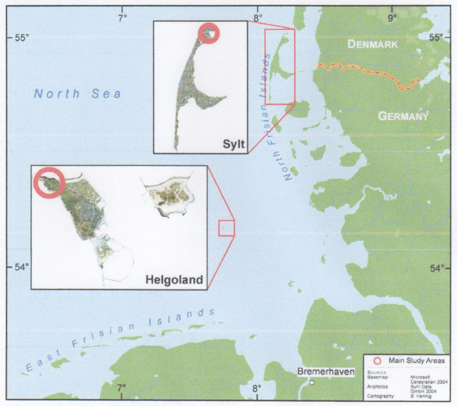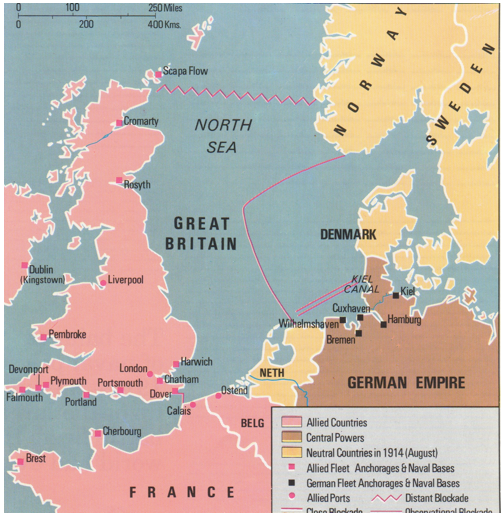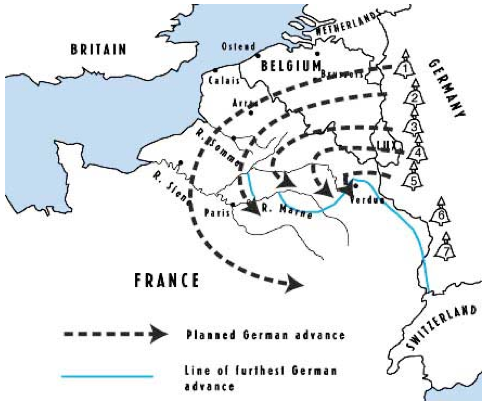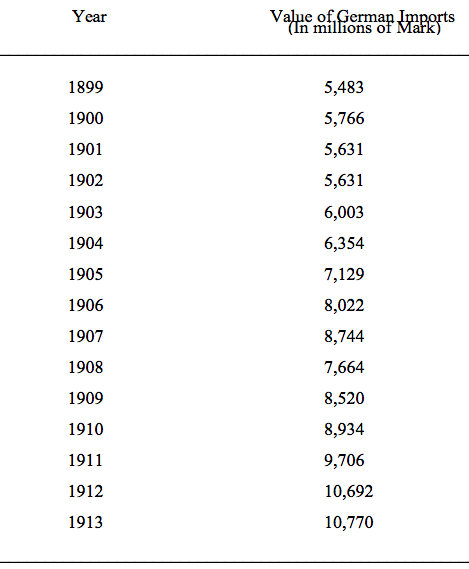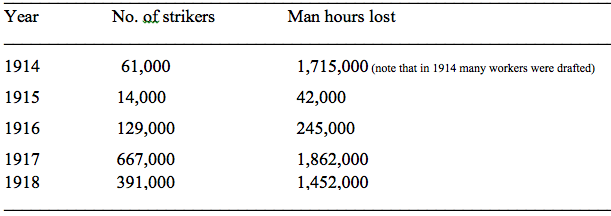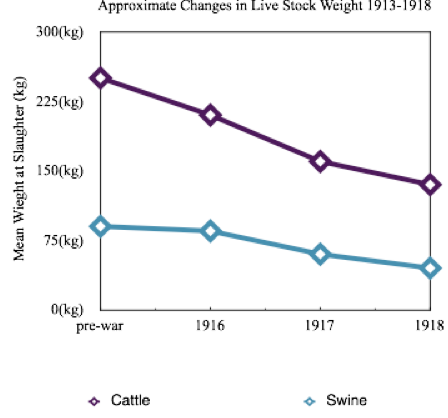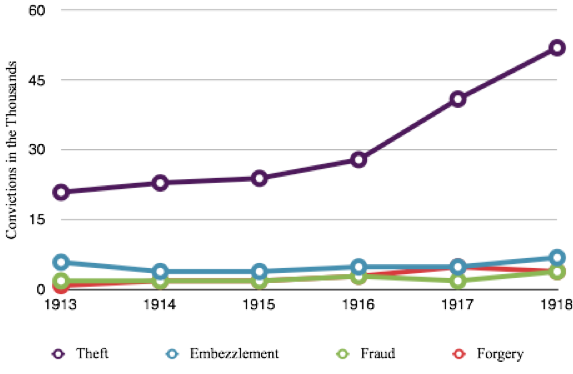Featured Article:The British Blockade During World War I: The Weapon of DeprivationBlockade Effects 1914-1916As we have seen so far, the blockade was more than just a naval operation where warships were placed along Germany's shores to prevent merchants from getting in, and the Germany navy from getting out. It was a complex multipart tool that cut Germany's trade from many different avenues. We can now begin to look at how it directly effected Germany and its people. This section will look at how the blockade specifically impacted the German economy and home front during the first two years of the war. To understand how the blockade affected Germany, we first need to demonstrate how the German economy changed in the years prior to the war. In the decade and a half before 1914, Germany began a new period of growth both in its population, and especially in its economy. In order to facilitate this growth, Germany needed access to goods that were outside its immediate control. They met this demand by nearly doubling the amount of their imports between 1899-1913 (see table 2.1 in Appendix).23 This meant that during the fifteen years preceding the outbreak of WWI, Germany became deeply dependent on obtaining goods from foreign merchants in order to keep its society stable and productive. To better demonstrate just how dependent Germany was on foreign goods we can look at what they were importing. During the years 1899-1913, on average nearly 77% of the total import tonnage was raw materials and chemicals needed to feed the tremendous growth in German industry. A significant portion of these chemical imports were sodium nitrate, a compound used by most German farmers to replenish nutrients lacking in the poor quality soil found throughout the country. Another 17.5% of the imported tonnage was foodstuff, while the remaining 4-5% of German imports were manufactured goods.24 What we can gain from this information is that Germany was predominately a manufacturing nation, and was heavily dependent on foreign raw materials to produce finished goods. We can also see that while Germany did produce the majority of its own food, they still needed to import foodstuff to fill in some of the gaps. According to Van Der Kloot, a majority of the imported foodstuff was not directly consumed by German civilians, but was used to feed livestock. This meant that an estimated 45% of all domestically produced foods were in one way or another connected to foreign imports.25 Thus while Germany may appear to be self sufficient in providing nourishment for its citizens, it relied heavily on getting products from abroad to feed its people.As we can see, Germany was highly dependent upon the uninterrupted flow of international trade. The German economy was thus not well suited to fighting in a total war of attrition where its primary supply of resources and ability to export finished goods would be severely hindered for long periods of time. As Alfred von Schlieffen - Chief of the Imperial German staff from 1899-1906 - noted "[long wars] are impossible in an age when the existence of the nation is founded upon the uninterrupted continuation of trade and industry. [...] A strategy of exhaustion cannot be conducted when the maintenance of millions depends upon the expenditure of billions."26 The best Germany could hope for was that its military could win a group of stunning victories that would win them the war within a few months, or at the most in little over a year. It was under this premise that Schlieffen designed the German battle plan that bore his name. The Schlieffen plan was built to be overtly aggressive, sending seven eighths of the Germany military - nearly 750,000 men - split into five armies westward first into neutral Belgium, and then 'like a monstrous rake' it would wheel south into France towards Paris.27 With the German push towards Paris, the French army would need to draw back away from its strong fortified areas in the east to blunt the threat to its capital. As the French moved in reverse, the five German armies would engage them in one massive battle of annihilation outside the gates of Paris (see Map 1.4 in Appendix).28 With the French defeated, the allied war effort would crumble quickly, thus saving Germany from the allied plans to starve them into submission. During the first eight months of the war, the blockade only affected the German home front in minor ways that can be described as more of a nuisance than actually being harmful to the health of the German population. A part of the reasoning behind this was the fact that the 1914 harvest had been planted before the war started. Also as noted before, during the first four months of the war, Britain did not attempt to confiscate imports that were not military in nature. Thus during this period Germany was largely able to obtain food imports from foreign traders. The only real shortages that were of any consequence during this early stage were imported delicacies not native to Central Europe such as rice, corn, and coffee. Changes in the availability of most food stocks began to reverberate throughout Germany late in the spring of 1915. The shortages seen here were the result of several issues. First by this point in the war the blockade had been in full operation for over half a year, and was running at peak efficiency. Also the government needed to requisition large quantities of food to feed the military; and finally the blockade cut Germany off from most sources of chemicals like salt peter and cordite, both used as propellants in munitions. To solve the latter problem, German chemists devised substitutes from regular foods such as milk, vegetable fats, and certain oils.29 The effects of this discovery only added to the diminishing availability of fatty foods and milk for civilian purchase. Also, although it was the government's decision to take such measures, they only needed to do so because the blockade had prevented them from acquiring these necessary compounds from any other source. Therefore a direct line can be drawn to the blockade for causing many of the shortages seen in late 1915 and early 1916. One group that was immediately affected by the loss in foods containing proper fat and protein values was German workers. Those individuals not working for an employer who provided extra food rations suffered because they were not able to obtain enough food to replenish their bodies from long hours at strenuous jobs. According to B.W. Kunkel, in order for the body to meet its basic needs, and have enough energy to perform 'light work,' the average human must consume at least 2000 calories a day. This estimation equated that the 2000 calories must include 100 grams of protein, 100 grams of fat, and 500 grams of carbohydrates.30 By the beginning of 1916, the effects of government rationing of food, and limited imports of foodstuff for over a year left workers and the average German citizen only able to obtain about 1700 calories a day; little of which was actually coming from protein and fats.31 Therefore malnutrition of both German factory workers and the rest of population began to grow quickly following the full establishment of the blockade. Two final groups that was severely affected by these losses in daily caloric intake were newborns and adolescents. The former suffered specifically from losses in milk, while the latter suffered from losses in foods containing high values of protein and carbohydrates. Newborns were affected most by the diminished food stocks because many German women opted to feed their newborns from the breast rather than by bottle. According to a report compiled by the Centre for Care of the Young - a German health clinic - beginning in mid to late 1915, women were unable to obtain enough food to meet their own basic bodily functions, which resulted in both less milk, and diminishing nutritional quality of what little milk they were producing.32 German adolescents also suffered because, while they generally ate more than their elders, the food they were served was not of a high nutritional value. Their bodies needed access to foods that were high in protein, carbohydrates, and fats in order to develop properly, and fight off disease. The immediate effects to this section of the population was stunted growth, sluggish performances in daily activity, and almost constant suffering from illness. During the year 1916 the food situation in Germany progressed from an impending crisis to a full blown disaster. Vincent noted that by this point in the war, government ration programs provided the average German with a meager diet of one loaf of dark bread, one slice of sausage - which contained little or no fat - and three pounds of potatoes per week.33 This scant diet was further cut down because of the growth in the black market, and subsequent rise in food prices. By this point during the war, only a trickle of goods were being imported from abroad because of the blockade. What little food was included in these imports often landed up on the black market, where prices could be ten times what they had been before the war. Also, food that was grown or raised in Germany more often than not found its way onto the black market, resulting in even more shortages. As food became increasingly more scarce, the price increased exponentially, leaving millions without the financial means to buy even the most basic food supplies. One eyewitness to the growing crisis was American correspondent George Schreiner, who noted that by the fall of 1916: Food had become the irreducible minimum. Not alone was the quantity on hand barely sufficient to feed the population, but its price could no longer be increased if the masses were not to starve for lack of money instead of lack of food. The daily bread ration was now a luxury. Men and women had to rise betimes and work late into the night if they wanted to eat at all.34 Thus German citizens were being starved because the blockade cut most avenues for Germany to obtain food from abroad, which caused dwindling supplies to increase in price, and become out of reach for millions of citizens. The blockade was not the only catalyst to severe food shortages experienced in 1916; one of the most detrimental causes was widespread crop failure. During the harvest of 1916, many countries throughout the world experienced crop failure due to adverse weather. Nowhere was this failure more destructive than in Germany because the country was mostly feeding its population by raising its own food supplies due to the blockade. The so called Kohlrübenwinter - turnip winter - was caused mainly by the failure of the potato crop due to heavy rains in autumn 1916. The increased moisture allowed fungi to grow on the potato crop, causing it to rot quickly.35 This crisis meant that the government needed to find replacements for potatoes since it was one of the primary provisions in Germany. The largest of these were the turnips, a crop that was considered only good enough to be used as animal feed in Germany. This distasteful substitute caused the already starving population to become hostile, and widespread unrest began to significantly grow for the first time during the war (see table 2.2 in appendix).36 Another way the government attempted to stem the loss of the potato and other foods was to issue thousands of substitutes know as ersatz. The first ersatz to reach German consumers were mostly nutritionally sufficient, however their taste, and often texture or other physical characteristics did not receive positive reactions from the public. One such ersatz was the Kriegsbrot, better known as the K-Brot. Strachan noted that this substitute was indeed perfectly adequate to replace traditional bread, but to the German civilians it neither tasted right, nor was its texture something to be desired.37 As food shortages continued to increase, the German government was forced to issue more and more ersatz; each of which became increasingly less flavorful, but even more importantly less nutritious too. As Ethel Cooper noted in 1916, "There is so little nourishment in the present food, that one always has an empty feeling an hour after a meal."38 An example of one of these later additions to the list of substitutes were sausage. Most ersatz sausage contained about five percent fat, leaving the rest of the content to be filled with some salt, vegetable leaves, and mostly water.39 Unlike the K-Brot which actually mimicked the nutritional value of real bread, these substitute sausages like many other ersatz did not. By the end of the war, more than 10,000 different ersatz were being distributed to the German populous, which only added to the already deteriorating moral and agitation of the German people. The harsh weather that ruined most of the potato crop in the fall of 1916 cannot be connected to the blockade, but the widespread malnutrition experienced by millions in late 1916, and the growth of thousands of unfulfilling substitute foods most defiantly can. Because Germany was unable to import anything in significant quantities, the government was forced to find alternative ways to meet the dietary needs of its population. In the beginning, these products were sufficient nutritionally, but as the war dragged on and few ingredients of substance were available, the salutary value of these provisions diminished. Had the blockade not been established, or had it remained along its original course of only confiscating military goods, then much of the food crises during this period could have been mitigated. Thus as the war dragged on, the blockade continued to serve its purpose by severely undermining Germany's home front moral, and the people's willingness to continue suffering indefinitely for the sake of the war.Continued on Next Page » Suggested Reading from Inquiries Journal
Inquiries Journal provides undergraduate and graduate students around the world a platform for the wide dissemination of academic work over a range of core disciplines. Representing the work of students from hundreds of institutions around the globe, Inquiries Journal's large database of academic articles is completely free. Learn more | Blog | Submit Latest in History |

